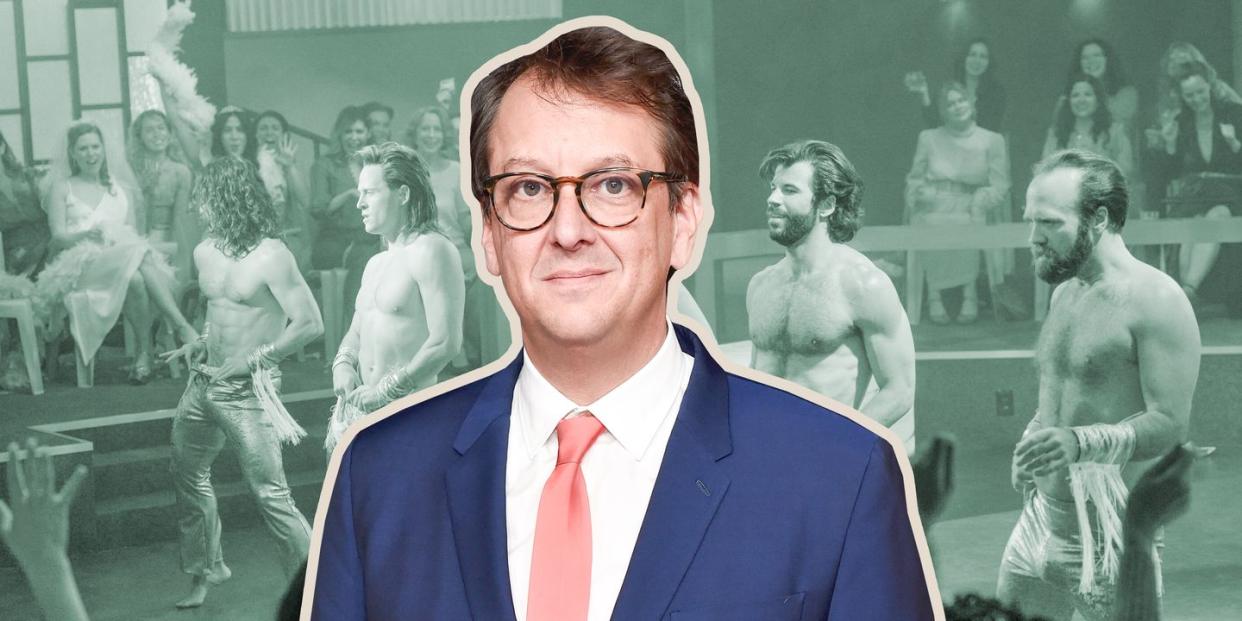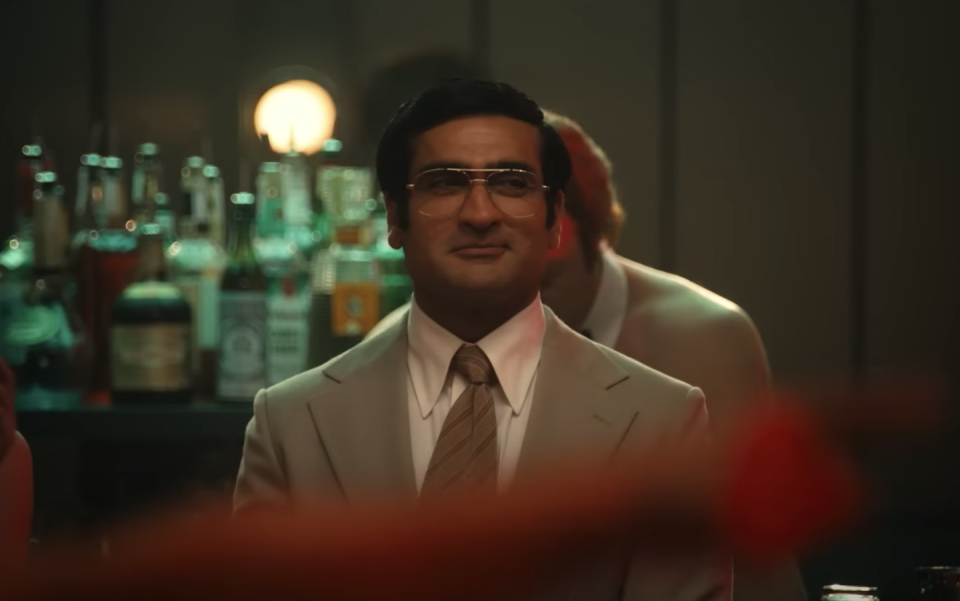How 'Welcome to Chippendales' Became the Antidote to True Crime Madness

- Oops!Something went wrong.Please try again later.
Living in a post-Magic Mike world, it’s easy to think of male strip clubs as something of a given in our modern society. But it wasn’t until the late '70s that the women’s equivalent of “Gentlemen’s Clubs” started gaining steam, with the echoes of the early decade’s sexual liberation movements finally ushering in the screams of women for a change. Call it a feminist breakthrough, but it didn’t take long before male dancing troupes started dominating marquees across the nation. And it all started with the Los Angeles troupe known as the Chippendales—a fun fact that its creator, Somen "Steve" Banerjee, would be sure to clarify here.
Hulu’s latest miniseries, Welcome to Chippendales, which premieres today, offers an origin story for today’s most widely-known male strip club. But you should know: it covers a lot more ground than where their signature bowties came from. (Hint: One of Banerjee’s greatest inspirations was Hugh Hefner.) If you’ve watched any of the Chippendales docuseries of recent years—or binged Spotify’s viral 2021 podcast, Welcome to Your Fantasy—then you know that the story of the Chippendales is one of true crime. It's also something of a classic rags-to-riches arc. Hell, maybe even a period piece, while we're at it.
Still, to showrunner Rob Siegel, the story of Welcome to Chippendales is much more than any of these labels. Which is exactly why he made sure to treat it as such. "You want to make something that doesn't feel like a Wikipedia page," the Pam & Tommy creator says of his approach to adapting true crime stories. “You always want to tell the true story without being bound to it or restricted by it.”
The result, underneath its sex, drugs, and rock and roll exterior, is a zoomed-in portrait of Banerjee that sees Kumail Nanjiani deliver a transformative portrayal of the ever-paranoid business mogul. With The White Lotus’s Murray Bartlett playing Banerjee's business partner, Nick Denoia, and supporting performances by Annaleigh Ashford and Juliette Lewis, the series sneaks a deeply compelling character study into its true crime appeal. With its first two episodes streaming now, Siegel sat down with Esquire to discuss the process of adapting Banerjee’s story for the screen.
After Pam & Tommy, what really drew you to take on Welcome to Chippendales as your next project?
Well, on a macro level, it checks all the boxes I look for, which is some element of sex, drugs, and rock and roll. I just love things that are, at first glance, somewhat trashy, fun, and have a real strong pop cultural bent. On a micro level, I want substance. I like things that are wildly entertaining and then sneak in some big, resonant themes when you're not looking. For Welcome to Chippendales, you got your mullets, your thongs, and your cocaine and your L.A. in the '70s—but it's also an opportunity to explore the American dream and immigration, racism, sexism, and capitalism. I also just love the character Steve Banerjee. He's a fascinating guy. I love the duality, the sort of fissure within his soul, that he's simultaneously fulfilling.
I mean, he's the picture-perfect model immigrant success story. You come to America, you work hard, you start a business, and you become a big success. That's the American dream—it's just he applied it to male stripping. And he came from this very conservative Indian culture that found that kind of scandalous. He really made his parents proud and also deeply embarrassed his them in the same act.
I thought it was really interesting how much of the series us centered upon Steve's roots, instead of the true crime of it all.
Yeah, the show was originally titled Immigrant. But the canvas of the show just progressively got bigger as I was writing it. It felt like Immigrant became too small, too reductive a title for it. But Immigrant is still the way I look at the series. The Chippendales— it's the backdrop. It's partially an origin story about how this very famous brand came to be born, but it's really more meant to be a character study of this guy.
After Pam & Tommy. I'm curious, how did your approach differ in adapting these two true crime stories?
I think the approach really was the same. But in this one, we had a lot less to go on. I guess that would be a difference. These people [in Welcome to Chippendales] were not alive, so I think that takes quite a bit of pressure off you to "do right" by them. There's also a lot more material out there about Pam and Tommy, including a lot of interviews with them. But there's almost nothing about Steve out there, and even less about his wife, Irene.
Did you work with anyone involved in the story who is still alive—even their family members?
No. There's a temptation to talk to people because you can get information and anecdotes that might be useful. But then it complicates your relationship with the material and ultimately you feel more inhibited. In some ways, when you have a relationship with someone, it's harder to be truthful. I find authorized biographies are usually less accurate than unauthorized. You build a certain allegiance to the person. It just complicates things in a way. Most people who write about real-life figures prefer not to meet them.
Are there any entirely fictionalized characters?
I would say Otis and Denise would fall into that category of mostly fictionalized. And then the only one that's truly fully fictionalized is Andrew Rannells's character, Bradford—Nick Denoia's lover.
How did you craft those composite characters?
I mean, filling out the world of the club and giving the characters people to bounce off of, really. I would say in the case of Denise, what that does is... Steve had such a strong ally in Irene, and we portray them in the show as these math nerds who are very business-minded. And we wanted Nick to have an ally, too. I didn't want it to be two against one. Just in the geometry of the structure of the show, I wanted to see Steve and Irene versus Nick and Denise. So, in the writer's room, we always referred to it as the “House of Steve” and “House of Nick.” House of Steve being the business side, House of Nick being the creative side. Those are the two that really the clash within the club: art versus commerce.
What can you say about how the actors prepared to play the real-life figures depicted in Welcome to Chippendales?
I mean, if you have really good actors, you don't really have to give them much direction. I think with Kumail, we talked a lot about how much of an accent he should have. We both felt like we didn’t want to play it for laughs. Kumail was very clear that he didn't want there to be any of what they call the Apu effect–named after the guy at the convenience store from The Simpsons. He didn't want this to be reduced to a South Asian stereotype or to play it for laughs, and we were on the same page with that. It's not like he's portraying Marilyn Monroe and everyone knows what this person sounds like or looks like.
And then with Irene, there was almost nothing to go on. So Annaleigh was pretty free to create. The only characters, if any, that some people come to this with some familiarity with would be Dorothy and Paul. In that case, we just didn't want to slavishly copy the Star 80 version.

Speaking of Star 80, Episode One ends with the murder of Dorothy Stratten by her boyfriend Paul Snider–which has since become an infamous moment in pop culture, thanks to projects like Star 80.
Well, what's not known, was the connection [between Dorothy and the Chippendales]. I didn't know anything about it. I mean, she was a really big influence in the early days of Chippendales, as was Paul. There's some dispute about who actually came up with the idea for the club. Paul claimed that he was the one who thought of the idea for a male strip club. And Dorothy was the one who came up with the idea for the cuffs and collars, obviously—because, at the Playboy clubs, the cocktail waitresses would wear cuffs and collars. In my research, it was even said that she actually went to Hugh Hefner to get permission for Chippendales to adopt that. And Hugh Hefner gave his blessing. It's not clear if that's true, but that's what I've read in a couple places.
We wanted to end the first episode on something dark and shocking—because there's so much fun in the first episode. And then to slam the door shut with this murder, it set the tone that there was going to be this dark undercurrent. What it also did was leave Steve alone. In the first episode, through much of the first episode, he picks up Nick and Paul along the way. Then in very quick succession, Nick takes his $3,000 and walks away and he's done. And then Paul is dead. So, we start Episode Two with Steve in this very lonely place. From there, he starts to rebuild. He brings Nick back, then Irene and Denise. And he has a family again.
You Might Also Like

